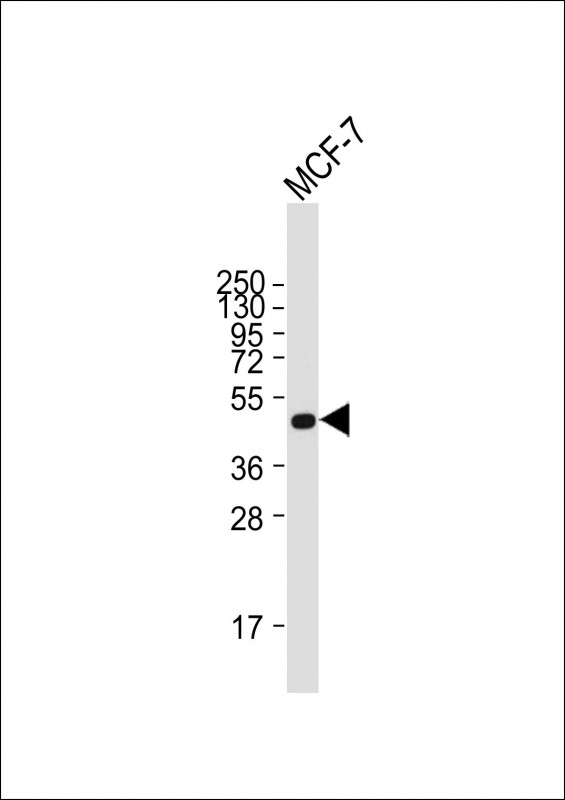SULT2B1
Purified Mouse Monoclonal Antibody (Mab)
- SPECIFICATION
- CITATIONS
- PROTOCOLS
- BACKGROUND

Application
| WB, E |
|---|---|
| Primary Accession | O00204 |
| Reactivity | Human |
| Predicted | Human |
| Host | Mouse |
| Clonality | monoclonal |
| Isotype | IgG1,κ |
| Clone/Animal Names | 2142CT1553.26.63 |
| Calculated MW | 41308 Da |
| Gene ID | 6820 |
|---|---|
| Other Names | Sulfotransferase family cytosolic 2B member 1, ST2B1, Sulfotransferase 2B1, 2.8.2.2, Alcohol sulfotransferase, Hydroxysteroid sulfotransferase 2, SULT2B1, HSST2 |
| Target/Specificity | This antibody is generated from a mouse immunized with a reconbinant protein from human. |
| Dilution | WB~~1:8000 E~~Use at an assay dependent concentration. |
| Format | Purified monoclonal antibody supplied in PBS with 0.09% (W/V) sodium azide. This antibody is purified through a protein G column, followed by dialysis against PBS. |
| Storage | Maintain refrigerated at 2-8°C for up to 2 weeks. For long term storage store at -20°C in small aliquots to prevent freeze-thaw cycles. |
| Precautions | SULT2B1 is for research use only and not for use in diagnostic or therapeutic procedures. |
| Name | SULT2B1 |
|---|---|
| Synonyms | HSST2 |
| Function | Sulfotransferase that utilizes 3'-phospho-5'-adenylyl sulfate (PAPS) as sulfonate donor to catalyze the sulfate conjugation. Responsible for the sulfation of cholesterol (PubMed:12145317, PubMed:19589875). Catalyzes sulfation of the 3beta-hydroxyl groups of steroids, such as, pregnenolone and dehydroepiandrosterone (DHEA) (PubMed:12145317, PubMed:16855051, PubMed:21855633, PubMed:9799594). Preferentially sulfonates cholesterol, while it also has significant activity with pregnenolone and DHEA (PubMed:12145317, PubMed:21855633). Plays a role in epidermal cholesterol metabolism and in the regulation of epidermal proliferation and differentiation (PubMed:28575648). |
| Cellular Location | Cytoplasm, cytosol. Microsome. Nucleus. Note=Phosphorylation of Ser-348 is required for translocation to the nucleus |
| Tissue Location | Expressed in the stratum granulosum-stratum corneum junction in the skin (at protein level) (PubMed:28575648). Expressed highly in placenta, prostate and trachea and lower expression in the small intestine and lung (PubMed:9799594) |

Thousands of laboratories across the world have published research that depended on the performance of antibodies from Abcepta to advance their research. Check out links to articles that cite our products in major peer-reviewed journals, organized by research category.
info@abcepta.com, and receive a free "I Love Antibodies" mug.
Provided below are standard protocols that you may find useful for product applications.
Background
Sulfotransferase that utilizes 3'-phospho-5'-adenylyl sulfate (PAPS) as sulfonate donor to catalyze the sulfate conjugation of many hormones, neurotransmitters, drugs and xenobiotic compounds. Sulfonation increases the water solubility of most compounds, and therefore their renal excretion, but it can also result in bioactivation to form active metabolites. Sulfates hydroxysteroids like DHEA. Isoform 1 preferentially sulfonates cholesterol, and isoform 2 avidly sulfonates pregnenolone but not cholesterol. Plays a role in epidermal cholesterol metabolism and in the regulation of epidermal proliferation and differentiation (PubMed:28575648).
References
Her C.,et al.Genomics 53:284-295(1998).
Grimwood J.,et al.Nature 428:529-535(2004).
Fuda H.,et al.J. Biol. Chem. 277:36161-36166(2002).
He D.,et al.Drug Metab. Dispos. 34:1749-1755(2006).
Salman E.D.,et al.J. Steroid Biochem. Mol. Biol. 127:315-323(2011).
If you have used an Abcepta product and would like to share how it has performed, please click on the "Submit Review" button and provide the requested information. Our staff will examine and post your review and contact you if needed.
If you have any additional inquiries please email technical services at tech@abcepta.com.













 Foundational characteristics of cancer include proliferation, angiogenesis, migration, evasion of apoptosis, and cellular immortality. Find key markers for these cellular processes and antibodies to detect them.
Foundational characteristics of cancer include proliferation, angiogenesis, migration, evasion of apoptosis, and cellular immortality. Find key markers for these cellular processes and antibodies to detect them. The SUMOplot™ Analysis Program predicts and scores sumoylation sites in your protein. SUMOylation is a post-translational modification involved in various cellular processes, such as nuclear-cytosolic transport, transcriptional regulation, apoptosis, protein stability, response to stress, and progression through the cell cycle.
The SUMOplot™ Analysis Program predicts and scores sumoylation sites in your protein. SUMOylation is a post-translational modification involved in various cellular processes, such as nuclear-cytosolic transport, transcriptional regulation, apoptosis, protein stability, response to stress, and progression through the cell cycle. The Autophagy Receptor Motif Plotter predicts and scores autophagy receptor binding sites in your protein. Identifying proteins connected to this pathway is critical to understanding the role of autophagy in physiological as well as pathological processes such as development, differentiation, neurodegenerative diseases, stress, infection, and cancer.
The Autophagy Receptor Motif Plotter predicts and scores autophagy receptor binding sites in your protein. Identifying proteins connected to this pathway is critical to understanding the role of autophagy in physiological as well as pathological processes such as development, differentiation, neurodegenerative diseases, stress, infection, and cancer.



